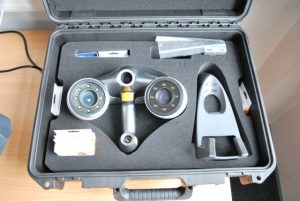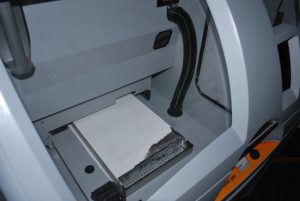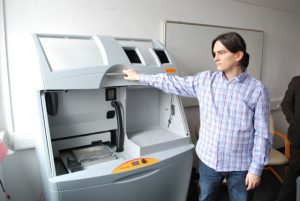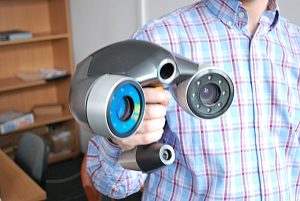Laboratory of Modern Technologies
Project co-financed by the European Regional Development Fund under ROP OV 2007-2013 “Creation of a modern IT technology laboratory at the University of Opole” Financing agreement no. RPOP.01.03.01-16-001 / 10-00 of 31.08.2010 “We invest in your future”.
Project goal
The goal of the Project should be the increase in the research and development potential of the Opole region working for an innovative economy by improving the conditions and quality of scientific and research works. The purchase of modern equipment for laboratories of the Institute of Mathematics and Computer Science of the University of Opole increased the possibilities of conducting innovative research, which in the future can be used for the development and modernization of IT infrastructure of enterprises.
It is anticipated that due to the modernization of the research base of the Institute of Mathematics and Computer Science of the University of Opole, the interest of business entities in conducting research in a modern laboratory of both industrial and service units will increase. Therefore, the project will increase the offer of R&D sector units in the Opolskie Voivodeship for the needs of the economy.
The broad impact of the Project is to strengthen the competitiveness of the Opolskie Voivodeship in the field of higher education, which will contribute to coupling the University with the city and the region, and to dynamize the development processes of the Opole region. Thanks to the implementation of the Project, the Opole University will strengthen its position as one of the region’s most important research centers. Increasing the technology transfer from science and research centers to enterprises that have or build IT infrastructure will affect their development both by increasing the quality of services offered and reducing the cost of operating IT systems.
Research carried out under the project
Research carried out under the project is divided into two directions:
- Testing possibilities of virtualization of IT resources,
person responsible for the above research direction: dr inż. Mariusz Gola - Modeling, image and space design in 2D and 3D graphics, and to support prototyping.
person responsible for the above research direction: mgr inż. Krystian Wojtkiewicz
 As part of the first direction of research related to virtualization of IT resources, computer and network equipment was purchased, consisting of, among others, two multiprocessor servers, network switches, measuring equipment and a set of portable computers. All this equipment was used to build a laboratory stand enabling the reflection of the company’s IT structure in terms of both servers and computer network. The laboratory stand is used to conduct scientific research in the field of virtualization techniques and optimization of network structures and optimization of the distribution of IT resources such as databases, Active Directory controllers, etc. Research related to virtualization of IT resources is carried out, among others, in the following directions: decrease in costs associated with the purchase of equipment, the possibility of dynamic resource allocation and more efficient load balancing, rapid adaptation of infrastructure to business expectations, rapid implementation and restoration of test environments. Virtual infrastructure means saving energy and reducing capital expenditure, high availability of resources, better computer management capabilities, and a higher level of security. Virtualization has very wide applications and responds to the needs of today’s business.
As part of the first direction of research related to virtualization of IT resources, computer and network equipment was purchased, consisting of, among others, two multiprocessor servers, network switches, measuring equipment and a set of portable computers. All this equipment was used to build a laboratory stand enabling the reflection of the company’s IT structure in terms of both servers and computer network. The laboratory stand is used to conduct scientific research in the field of virtualization techniques and optimization of network structures and optimization of the distribution of IT resources such as databases, Active Directory controllers, etc. Research related to virtualization of IT resources is carried out, among others, in the following directions: decrease in costs associated with the purchase of equipment, the possibility of dynamic resource allocation and more efficient load balancing, rapid adaptation of infrastructure to business expectations, rapid implementation and restoration of test environments. Virtual infrastructure means saving energy and reducing capital expenditure, high availability of resources, better computer management capabilities, and a higher level of security. Virtualization has very wide applications and responds to the needs of today’s business.
 As part of the second direction of research related to modeling and designing images and spaces in 2D and 3D graphics, and prototyping support, specialized equipment consisting of a 3D printer, 3D scanner and graphic station was purchased. This equipment was used to build a laboratory stand enabling multi-directional research related to 3D design. 2D and 3D design is a constantly growing field in computer science. The main focus is on optimizing the recording of information about objects, creating point meshes, and the textures used. An important issue is also the mapping of real objects and spaces, which are then used for CAD design. In the aspect of prototyping, the needs for rapid production of test models, whose main task is visualization of the design stage, are still unmet. Fast and cheap printing of three-dimensional objects using a high quality composite will allow efficient testing of engineers’ ideas.
As part of the second direction of research related to modeling and designing images and spaces in 2D and 3D graphics, and prototyping support, specialized equipment consisting of a 3D printer, 3D scanner and graphic station was purchased. This equipment was used to build a laboratory stand enabling multi-directional research related to 3D design. 2D and 3D design is a constantly growing field in computer science. The main focus is on optimizing the recording of information about objects, creating point meshes, and the textures used. An important issue is also the mapping of real objects and spaces, which are then used for CAD design. In the aspect of prototyping, the needs for rapid production of test models, whose main task is visualization of the design stage, are still unmet. Fast and cheap printing of three-dimensional objects using a high quality composite will allow efficient testing of engineers’ ideas.
As part of the commenced scientific research, cooperation was established with several enterprises of the Opole region for the performance of scientific research within the created laboratory. The result of the work is the signing of cooperation agreements between the Opole University and enterprises.
Project development
A few words about virtualization
Virtualization allows simultaneously running multiple operating systems on the same hardware and system platform – while maintaining the maximum possible performance. As a consequence, it allows extremely efficient use of existing equipment and any modification of the features of virtualized resources, so that they always meet the current expectations of users.
Virtualization provides the following benefits:
- Decrease in costs related to the purchase of equipment,
- business continuity – reduction of system recovery times, reduction of Disaster Recovery costs, simpler implementation of procedures,
- possibility of dynamic resource allocation and more efficient load balancing, quick adaptation of infrastructure to business expectations,
- consolidation – consolidation of existing environments, increasing the resource utilization ratio, reducing operating costs,
- application testing and development – quick implementation and restoration of test environments.
 The rapid increase in processor computing power combined with a jump in energy prices meant that many companies are increasingly starting to introduce server consolidation solutions with a view of improving performance and providing more flexibility for more efficient business operations. In most data centers, actual server loads consume less than 15% of potential equipment power. However, security and performance considerations and the need to ensure uninterrupted work mean that IT managers often deploy hardware on a “one physical server – one task” basis. The introduction of new, high-performance servers is causing infrastructure expansion because older computers are not being retired. In this way, a large part of the potential remains unused, which is associated with the servers taking up too much space, greater requirements related to cooling and excessive power consumption.
The rapid increase in processor computing power combined with a jump in energy prices meant that many companies are increasingly starting to introduce server consolidation solutions with a view of improving performance and providing more flexibility for more efficient business operations. In most data centers, actual server loads consume less than 15% of potential equipment power. However, security and performance considerations and the need to ensure uninterrupted work mean that IT managers often deploy hardware on a “one physical server – one task” basis. The introduction of new, high-performance servers is causing infrastructure expansion because older computers are not being retired. In this way, a large part of the potential remains unused, which is associated with the servers taking up too much space, greater requirements related to cooling and excessive power consumption.
The created laboratory would allow research, the results of which could encourage enterprises to implement virtualization solutions, which in a short time would have a measurable effect both in financial terms and in improving the overall security of IT resources.
Modeling, image and space design in 2D and 3D graphics, and to support prototyping.
As part of modeling using three-dimensional technology, the ZScanner® 700CX scanner is used to obtain the accuracy of three-dimensional scans in individual spaces:
- up to 50 microns
- Z 0.1mm


And texture accuracy from 50 to 250 DPI.
Ready-made 3D models can be printed, i.e. prototyping support can be obtained. The printer is equipped with Sprinter® 450. This printer prints elements with the maximum size of one part 203 x 254 x 203mm, and the resolution of the applied color texture is 300 x 450 DPI.


